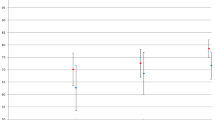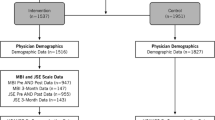Abstract
Purpose: To evaluate and compare the effects of two types of continuing medical education (CME) programs on the communication skills of practicing primary care physicians.
Participants: Fifty-three community-based general internists and family practitioners practicing in the Portland, Oregon, metropolitan area and 473 of their patients.
Method: For the short program (a 4 1/2-hour workshop), 31 physicians were randomized to either the intervention or the control group. In the long program (a 2 1/2-day course), 20 physicians participated with no randomization. A research assistant visited all physicians’ offices both one month before and one month after the CME program and audiotaped five sequential visits each time. Data were based on analysis of the content and the affect of the interviews, using the Roter Interactional Analysis Scheme.
Results: Based on both t-test analysis and analysis of covariance, no effect on communication was evident from the short program. The physicians enrolled in the long program asked more open-ended questions, more frequently asked patients’ opinions, and gave more biomedical information than did the physicians in the short program. Patients of the physicians who attended the long program tended to disclose more biomedical and psychosocial information to their physicians. In addition, there was a decrease in negative affect for both patient and physician, and patients tended to demonstrate fewer signs of outward distress during the visit.
Conclusion: This study demonstrates some potentially important changes in physicians’ and patients’ communication after a 2 1/2-day CME program. The changes demonstrated in both content and affect may have important influences on both biologic outcome and physician and patient satisfaction.
Similar content being viewed by others
References
Waitzkin H. Doctor-patient communication: clinical implications of social scientific research. JAMA. 1984;252:2441–6.
DiMatteo MR, DiNicola DD. Achieving Patient Compliance. New York: Pergamon Press, 1982;35–40.
Mumford E, Schlesinger HJ, Glass GV. The effects of psychological intervention on recovery from surgery and heart attacks: an analysis of the literature. Am J Public Health. 1982;72:141–51.
Greenfield S, Kaplan S, Ware JE Jr. Expanding patient involvement in care. Ann Intern Med. 1985;102:520–8.
Korsch BM, Gozzi EK, Francis V. Gaps in doctor-patient communication. I. Doctor-patient interaction and patient satisfaction. Pediatrics. 1968;42:855–71.
Shapiro RS, Simpson DE, Lawrence SL. A survey of sued and nonsued physicians and suing patients. Ann Intern Med. 1989;149:2190–6.
Adamson TE, Tschann JM, Guillion DS, Oppenberg AA. Health care delivery: physician communication skills and malpractice claims. A complex relationship. West J Med. 1989;150(3):356–60.
Applegate WB. Physician management of patients with adverse outcomes. Arch Intern Med. 1986;146:2249–52.
Verby V, Holden P, Davis R. Peer review of consultations in primary care: the use of audiovisual recordings. B M J. 1979;1:1686–8.
Gask L, Goldberg D, Lesser AL, Millar T. Improving the psychiatric skills of the general practice trainee: an evaluation of a group training course. Med Educ. 1988;22:132–8.
Verby J, Davis RH, Holden P. A study of the interviewing skills of trainee assistants in general practice. Patient Counsel Health Educ. 1980;Second Quarter:68–71.
Gask L, Goldberg D, Porter R, Creed F. The treatment of somatization: evaluation of a teaching package with general practice trainees. J Psychosom Res. 1989;33(6):697–703.
Gask L, McGrath G, Goldberg D, Millar T. Improving the psychiatric skills of established general practitioners: evaluation of group teaching. Med Educ. 1987;21:362–8.
Keller V, Carroll JG. Miles Program for Physician-Patient Communication. Presented at the 13th Annual Conference on Patient Education, Marriott Rivercenter, San Antonio, TX, Nov 1991;39–52.
Lipkin M, Quill TE, Napodano RJ. The medical interview: a core curriculum for residencies in internal medicine. Ann Intern Med. 1984;100:277–84.
Smith RC, Hoppe RB. The patient’s story: integrating the patient-and physician-centered approaches to interviewing. Ann Intern Med. 1991;115:470–7.
Levenstein JH, Brown JB, Weston W, Stewart M, McCracken EC, McWhinney I. Patient centered clinical interviewing. In: Stewart M, Roter DL (eds). Communicating with Medical Patients. London: Sage Publications, 1989; 107–20.
Roter D, Hall J, Katz N. Patient-physician communication: a descriptive summary of the literature. Patient Educ Counseling. 1988;12:99–119.
Hall JA, Roter DL, Katz NR. Meta-analysis of correlates of provider behavior in medical encounters. Med Care. 1988;26:657–75.
Hall JA, Dornan MC. Meta-analysis of satisfaction with medical care: description of research design and analysis of overall satisfaction levels. Soc Sci Med. 1988;27:637–44.
Roter DL. The Roter Interactional Analysis System (RIAS) Coding Manual 1990. Available upon request from the author (coauthor of this article).
Gotman JM. Experimental Investigations. New York: Academic Press, 1979.
Wolraich ML, Albanese M, Stone G, et al. Medical communication behavior system, an interactional analysis system for medical interactions. Med Care. 1986;24:891–903.
Bensing JM, Dronkers J. Instrumental and affective aspects of doctor-patient communication. In: Bensing J (ed) Doctor — Patient Communication and the Quality of Care. Utrecht, The Netherlands: Nivel, 1991;133–57.
Roter DL, Hall JA. Physicians’ interviewing styles and medical information obtained from patients. J Gen Intern Med. 1987;2:325–9.
Weiner S, Nathanson M. Physical examination: frequently observed errors. JAMA. 1986;236:852–5.
Platt FW, McMath JC. Clinical hypocompetence: the interview. Ann Intern Med 1984;91:898–902.
Carter WB, Inui TS. How Patients Judge the Humanistic Skills of their Physicians. Philadelphia: American Board of Internal Medicine Final Report on the Patient Satisfaction Questionnaire Project, 1989.
Bertakis KD, Roter DL, Putnam SM. The relationship of physician medical interview style to patient satisfaction. J Fam Pract. 1991;32:175–81.
Houpt JL, Orleans CS, George LK, Brodie HK. The Importance of Mental Health Services to General Health Care. Cambridge, MA: Ballinger, 1979.
Goldberg RL, Haas MR, Eaton JS. Psychiatry and the primary care physician. JAMA. 1976;236:994–5.
Greenfield S, Kaplan SH, Ware JE Jr, Yano EM, Frank HJL. Patients’ participation in medical care: effects on blood sugar control and quality of life in diabetes. J Gen Intern Med. 1988;3:448–57.
Stewart M, Brown JB, Weston WW. Patient-centered interviewing. Part III: Five provocative questions. Can Fam Phys. 1989;35:159–61.
Roter D, Frankel R. Quantitative and qualitative approaches to the evaluation of the medical dialogue. Soc Sci Med. 1992;34:1092–103.
Kaplan SH, Greenfield S, Ware JE Jr. Assessing the effects of physician — patient interactions on the outcomes of chronic disease. Med Care. 1989;27(suppl):S110-S127.
Inui TSS, Carter W. Problems and prospects for health services research on provider-patient communication. Med Care. 1985;23:521.
Roter DL, Hall JA. Training of primary care physicians in interviewing skills to identify and address patients’ psychosocial distress. Clin Res. 1992;40(2):617A.
Heifer, RE, Black MA, Tietelbaum H. A comparison of pediatric interviewing skills using real simulated mothers. Pediatrics. 1975;55:397–400.
Author information
Authors and Affiliations
Rights and permissions
About this article
Cite this article
Levinson, W., Roter, D. The effects of two continuing medical education programs on communication skills of practicing primary care physicians. J Gen Intern Med 8, 318–324 (1993). https://doi.org/10.1007/BF02600146
Issue Date:
DOI: https://doi.org/10.1007/BF02600146




